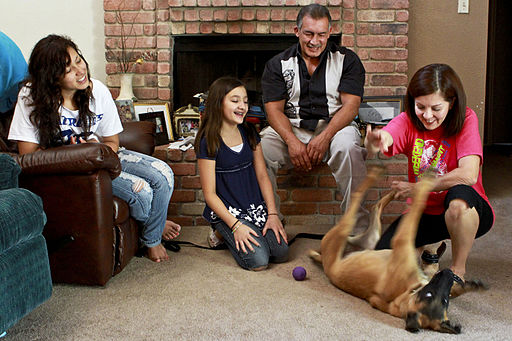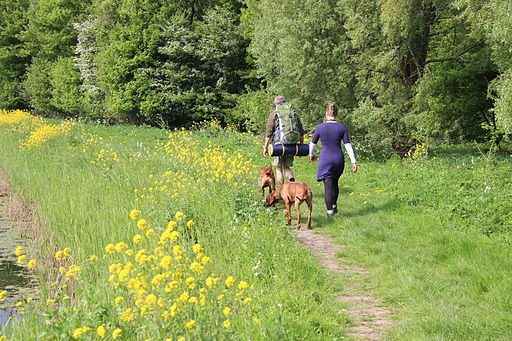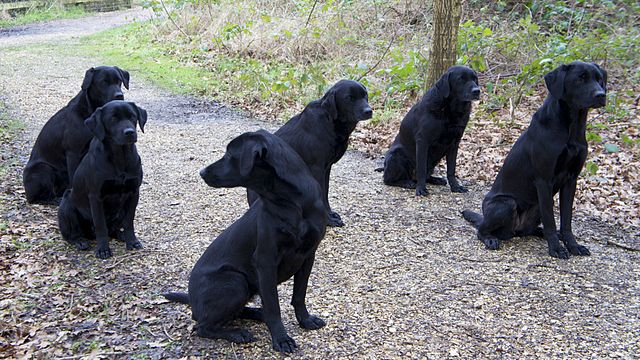Basic Dog Training and Bonding With Your Dog
These are some concepts that can help you when you are beginning to do some training with your dog.
Any time spent with your dog is also a good time to be building the bond you would like to have with him.
It can also be useful to keep in mind the instincts that motivate and form much of your dog’s behavior.
Your Group is Your Pack!
Some of these instincts include the need to belong to your group or pack, in dog terms.
Your pack consists of you, members of your household, and any other pets that are part of your group.
Membership in your pack gives your dog’s life structure, meaning and a sense of completeness.
When we first brought home Balto as a young pup, this was made quite clear.
For his first few weeks with us, he seemed more concerned with finding his place among the animal members of our pack than with we human members.
Once he had relations with the other animals worked out, then he paid more attention to relating to humans.
Belonging to your pack is one of the strongest instincts your dog has.
Build Trust and Respect
You may also wish to consider the ways you can encourage your dog to trust and respect you.
This would include setting boundaries for your dog and using firm but calm discipline when enforcing those boundaries. Anger should have no part in your discipline.
Your dog can learn that almost all good things, food, exercise, and affection, come thru you and that he can trust you for these things.
Some ways to help you build this trust include:
- Spending active time with your dog in planned and routine activities
- Introducing your dog to the larger world in safe situations where he can build confidence
- Developing verbal and non verbal cues with your dog as communication
You will be developing a well balanced dog as a result, and preparing your dog for more advanced training if desired.
I have developed some hand cues that have replaced verbal cues with my dogs. I first associated the hand cues with the verbal by using both at the same time. Later I just dropped the verbal cues.
In some of the “work” situations described in the blog “Real dog Stories” I let the dogs make some trail decisions which also seems to build their confidence.
Is there a secret to training?
There is a certain underlying principle that I believe makes training and bonding your dog much easier.
Forgive me if this sounds silly at first, but please remember that you are working with a dog.
You are not working with a human in a fur suit even if you view your dog as a child substitute,
Respect your dog to the point that you will let him be a DOG.
As silly as this might have sounded at first, we humans “anthropomorphize” animals all the time on TV, in cartoons, books etc.
In other words we project human qualities onto our dogs.
We often treat our pets like little humans, but they are not. This can even cause behavior problems.
Respect your dog enough to let him be a dog and you will have a well adjusted dog that is much more easily trained and bonded with.
How does your dog learn?
One way is by observation.
If there is a way to demonstrate what you would like your dog to do, finding a way to show him is very helpful.
With work type activities dogs can learn a lot by watching other dogs work.
Dogs can also pickup bad habits by watching other dogs, so be careful!
I like to catch my dog doing something that I want as a command and say the word just before or as he does the action.
For example if you walk with your dog, with or without a leash, on a familiar route you will know where to expect turns.
When a right turn is coming up I would call my dog’s name and say “gee” (meaning turn right).
After we complete the turn, which we would have done anyway, I give a verbal reward, “good boy”.
I have had outstanding results with this simple approach. This also sets you up very nicely for more advanced training.
It is good to call your dog’s name before using a command. This can
- Get your dog’s attention
- Let your dog know that a command will follow or something is about to happen.
And of course practice with patience, persistence and praise.
I have heard it said that with your pets you are always either
- Training or
- Detraining.
Don’t miss an opportunity to use the training and cues you have developed with your dog.
Consistency is key. You don’t want your dog confused about when to carry out your commands.
As you and your dog gain some skills, you can try them out in more difficult or distracting settings.
If all goes well great! Repeat to maintain consistency and try something more difficult if you like.
Experience
Keep active with your dog and add additional skills or activities as you desire.
There is a tremendous gain in performance as a dog gains experience. I’ll bet you get better too!
Let your dog know when he makes a mistake in a matter of fact but firm matter.
Then show him or have him do it right.
Make sure to reward performance verbally, with affection, or with touch.
I personally don’t use treats or clickers for my dog activities .
Keep things fun. If working on endurance go just a little bit longer.
Results
Patience and persistence will produce experience, which leads to results.


